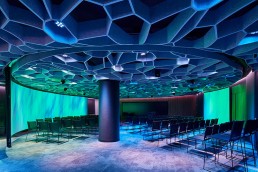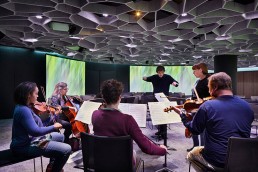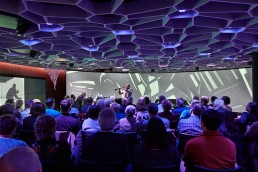This website uses cookies so that we can provide you with the best user experience possible. Cookie information is stored in your browser and performs functions such as recognising you when you return to our website and helping our team to understand which sections of the website you find most interesting and useful.
EMEA & APAC AWARDS • THE AMERICAS AWARDS
Octave 9
ProjectOctave 9LocationSeattle, WashingtonManufacturersMeyer SoundArchitectLMN Architects, USAImmersive Tech DesignerBelle & Wissell, Co., USAAcousticianJaffe Holden, USASubmitted byMeyer Sound
Equipped with Meyer Sound’s Constellation active acoustics and Spacemap spatial sound, Octave 9 affords virtually limitless potential for exploring new ways to create, present and experience music from all genres and eras — from string quartets and vocal ensembles to contemporary electronic — in a richly immersive environment.
Constellation is a highly refined system of active acoustics. By applying DSP coupled to multiple ambient sensing microphones and an array of evenly distributed lateral and overhead loudspeakers, Constellation modifies the room’s acoustic characteristics by adding early reflections and/or reverberation to create the optimum acoustics for the event at hand. Acoustic characteristics are generated using the patented VRAS (Variable Room Acoustical System) algorithm.
As implemented at Octave 9, Constellation comprises 62 small full-range loudspeakers augmented by 10 compact subwoofers that extend the reverberation envelope through the deep bass frequencies. 28 miniature microphones are spread across the ceiling for ambient sensing. DSP is supplied by a D-Mitri digital audio platform with 13 modules, including two D-VRAS modules for separate control of early reflections and reverberation. Available system presets can instantly transform room acoustics to emulate a small room, medium room, large hall or cathedral.
The suite of Meyer Sound technologies also includes Spacemap, a software-based system for exploring three-dimensional spatial sound through the dynamic movement of discrete sounds around, over and through the audience.
Octave 9’s street-level space had been previously occupied by Soundbridge, a modest venue primarily devoted to educational programs. It had hosted small ensemble performances, but the room’s limited size and low ceiling provided limited and fixed acoustical support.
The architecture of the space, including the innovative ‘honeycomb’ acoustical ceiling, was designed by LMN Architects in Seattle working in collaboration with principal acoustical and AV consultant, Garth Hemphill of Jaffe Holden.
For a full sensory experience, the sonic effects of Constellation are complemented by equally advanced visual technologies as designed by Belle & Wissell, Co. of Seattle. Visual effects are displayed on moveable screens that can fully surround the space with images displayed on 10 ultra-short throw projectors.
Octave 9’s street-level space had been previously occupied by Soundbridge, a modest venue primarily devoted to educational programs. It had hosted small ensemble performances, but the room’s limited size and low ceiling provided limited and fixed acoustical support.
Constellation comprises 62 small full-range loudspeakers augmented by 10 compact subwoofers that extend the reverberation envelope to the lowest bass frequencies. All loudspeakers are self-powered using Meyer Sound’s proprietary IntelligentDC technology. Twenty-eight miniature microphones are spread across the ceiling for ambient sensing.
Constellation is a flexible and highly refined system of active room acoustics. By applying digital signal processing coupled to multiple ambient sensing microphones and an array of evenly distributed lateral and overhead loudspeakers, Constellation extends or modifies the room’s reverberant characteristics to create the optimum acoustics for the event at hand. With Constellation, the same physical space can emulate the acoustics of an ideal classroom, chamber music hall, symphony hall or vast cathedral.
Constellation is not a ‘PA system’ or a ‘surround sound system.’ It does not amplify direct microphone signals from individual voices or instruments, nor is it designed to place discrete sound sources off to the sides or rear of the room. The latter effect can be realised at Octave 9 with unprecedented flexibility by using Spacemap. Spacemap provides multi-channel panning, allowing artists the ability to easily explore the creative possibilities of three-dimensional spatial sound. Spacemap software is included with D-Mitri. Unlike Constellation, which creates a diffuse acoustic environment, Spacemap allows the manipulation of discrete sounds around, over and within the audience. The individual sounds can be anything – voices, sound effects, individual instruments or ensembles, live or pre-recorded. The sounds can be placed anywhere in the room in a static position or dynamically moved through the space either as pre-programmed or on-the-fly as part of a real-time performance. At Octave 9, Spacemap shares the same loudspeakers and D-Mitri DSP platform with Constellation but includes a custom touchscreen user interface that has been configured for this installation. Spacemap does not use the ambient sensing microphones.
Constellation also offers a ‘voice lift’ feature for use with spoken word applications. For voice lift, Constellation augments the early reflections coming from near the person speaking. It emulates the effect of the reflective surfaces at the front of churches and lecture halls built in the era before amplification, reinforcing a voice without electrical amplification. However, unlike the physical spaces of old, Constellation can apply this effect flexibly throughout the auditorium, so audience members’ questions and comments also can be heard without ‘pass around’ wireless microphones. Voice lift is put to good use for lecture and discussion programs at Octave 9: Raisbeck Music Center.
The Seattle Symphony has expanded creative possibilities for musical performance and composition throughout the community with the opening of Octave 9: Raisbeck Music Center, an intimate venue inside the orchestra’s home at Benaroya Hall in downtown Seattle. Equipped with Meyer Sound’s Constellation active acoustics and Spacemap spatial sound, Octave 9 affords virtually limitless potential for exploring new ways to create, present and experience music from all genres and eras — from string quartets and vocal ensembles to contemporary electronic — in a richly immersive environment. The response to Octave 9 — from critics and audiences alike — to both the marathon and the first concerts has been enthusiastic, if not ecstatic.
Octave 9 was introduced to the Seattle music community with a non-stop, 24-hour music marathon on March 23 and 24. Musical selection encompassed everything from multi-track electronics to solo instruments and percussion ensembles.
Octave 9: Raisbeck Music Center is the first Constellation acoustic system in the state of Washington, incorporating the latest developments in advanced technologies for acoustic space emulation and dynamic spatial sound manipulation. It is the first Constellation system to be commissioned with an easy to use multi-touch interface that offers real-time manipulation of up to 32 independent, discrete sound sources using Spacemap. It has dedicated system presets to optimise acoustics for any type of event, with options for small room, medium room, large hall, and sacred space. Acoustic presets have been optimised for use with multiple screen configurations that will provide the room with both immersive visual and sonic possibilities.



